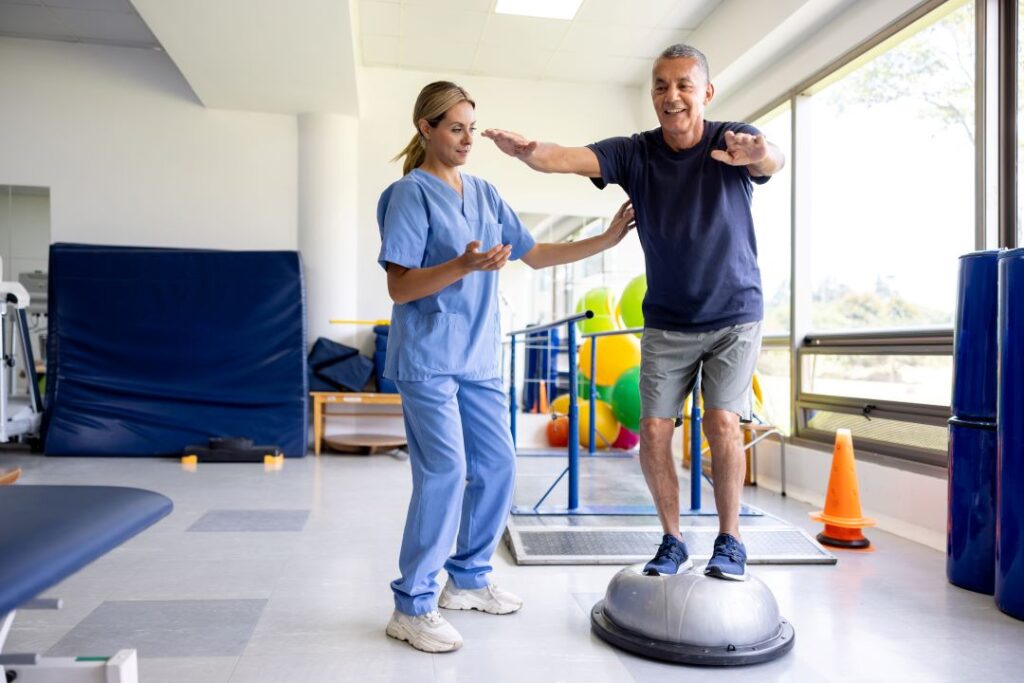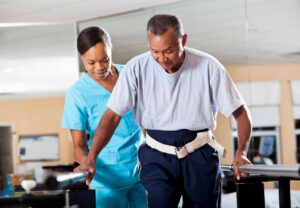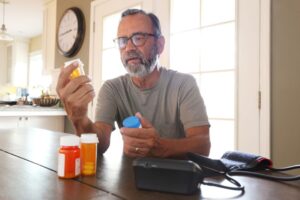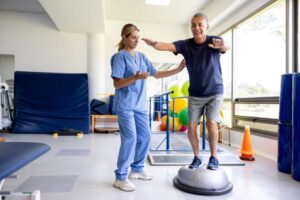Falls are one of the most significant health risks for older adults. In 2021, U.S. emergency departments reported close to 3 million visits due to a fall by someone 65 or older; that same year, falls caused more than 38,000 senior deaths, the leading cause of death by injury. But falls can be prevented with the right support, including targeted physical therapy (PT) in nursing and rehabilitation settings.
How physical therapy prevents falls
Falls are not a natural part of aging. Physical therapy can strengthen the body, improve coordination, and restore confidence in mobility; physical therapists are experts in movement. Research shows that the benefits of PT for fall prevention outweigh the costs, particularly due to its positive impact on an individual’s quality of life. Nursing and rehabilitation services, like those provided by Four Seasons, offer structured PT programs tailored to each individual’s needs which can encompass everything from exercises to home safety education.
Here are some ways PT can reduces fall risks:
- Balance training. Specialized exercises help improve stability, preventing unsteady steps that can lead to falls.
- Strength building. Weak muscles contribute to instability. PT focuses on strengthening key muscle groups, particularly in the legs and core, to support safer movement.
- Gait assessment and correction. Physical therapists analyze walking patterns and recommend changes to improve posture, stride, and coordination.
- Assistive device training. If a walker or cane is needed, PT ensures proper usage to maximize safety.
- Environmental navigation practice. PT sessions can simulate real-world challenges, like stepping over obstacles or walking on uneven surfaces, preparing seniors for safer mobility in daily life.
Simple exercises to try
In addition to professional PT, seniors can benefit from simple exercises at home to improve strength and stability. Here are three easy exercises to get started:
- Heel-to-toe walk. Walk in a straight line, placing the heel of one foot directly in front of the toes of the other. This helps improve balance and coordination.
- Chair stand exercise. Sit in a sturdy chair and slowly rise to a standing position without using hands for support. Repeat 10-15 times to build leg strength.
- Single leg stands. Hold onto a stable surface and lift one foot off the ground, balancing on the other for 10-15 seconds. Switch legs and repeat. This enhances stability and strength.
How caregivers can help with fall prevention
Caregivers can play an essential role in keeping seniors safe from falls. Caregivers hold a unique position and can talk to loved ones about risks as well as partner in fall prevention. Some proactive steps caregivers can take to minimize fall risks include:
- Ensure a safe home environment. Remove loose rugs, secure cords, and keep walkways well-lit to reduce tripping hazards.
- Encourage regular exercise. Cheerlead and support participation in physical therapy or home exercises to maintain strength and mobility.
- Monitor medications. Some medications can cause dizziness or balance issues. Caregivers can help track side effects and discuss concerns with healthcare providers.
- Promote proper footwear. Check that loved ones are wearing well-fitting, non-slip shoes instead of loose slippers or socks on hard floors.
- Schedule vision and hearing checks. Impaired vision or hearing can contribute to falls. Regular screenings help address these risks proactively.
Preventing falls is key to not only maintaining good health, but it also allows individuals to keep their independence and quality of life. Four Seasons Healthcare Solutions in Brooklyn offers expert PT and rehabilitation services designed to enhance strength, balance, and overall safety. If you or a loved one could benefit from PT for fall prevention, contact us today to learn more about how we can help keep your loved ones safe and active.
###
Sources: CDC; APTA; NCOA; NCBI; John Hopkins Medicine












